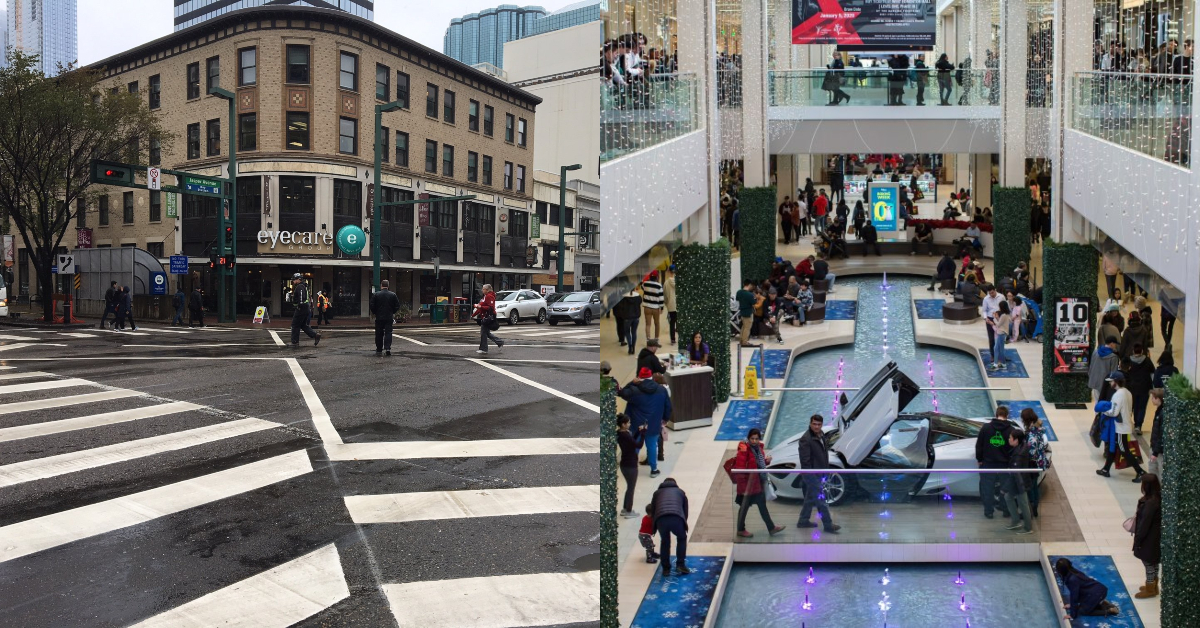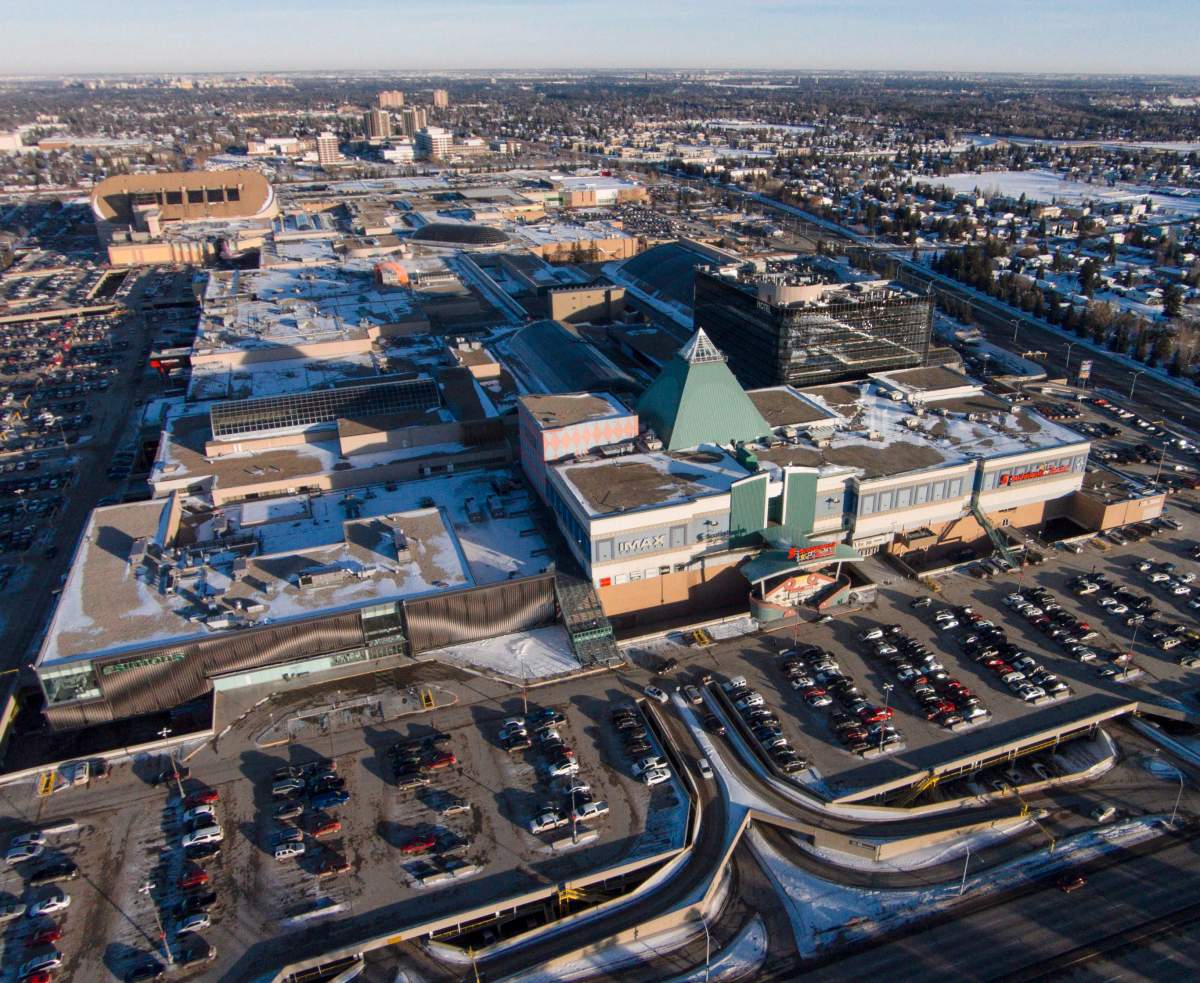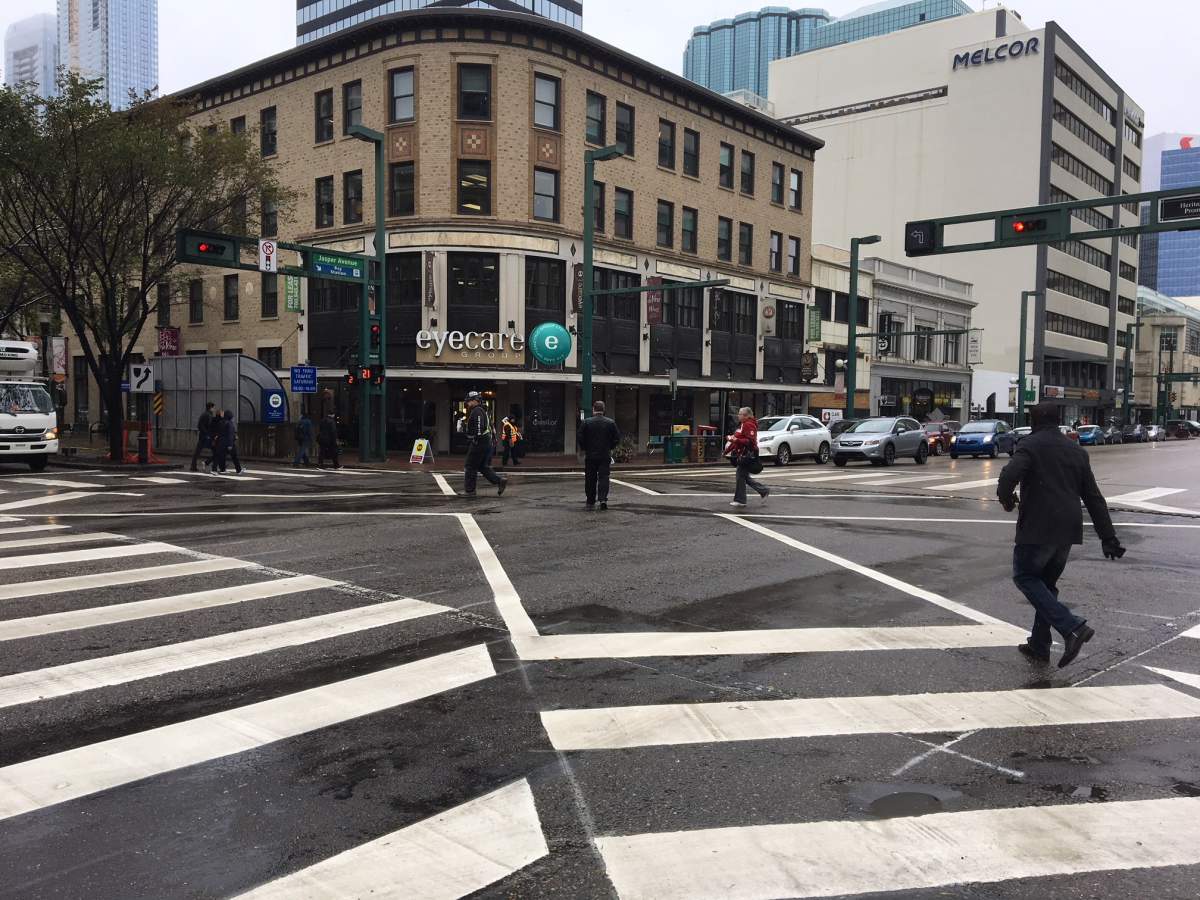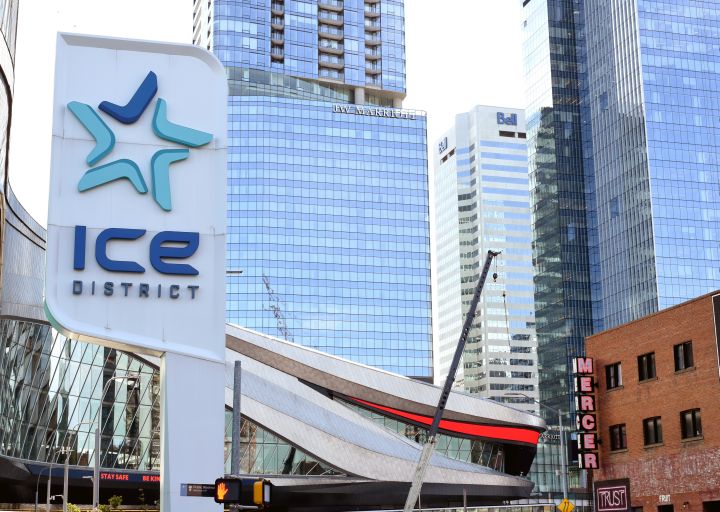It was 40 years ago this week that a relatively small city in northern Alberta saw the world’s largest shopping centre open its doors about 12 kilometres away from the downtown core.

Ever since, not only has West Edmonton Mall and the city centre in Alberta’s capital continued to evolve, but so too has the discussion about the megamall’s impact that many feared would leave downtown Edmonton in its shadow.
While it continues to attract throngs of shoppers and find ways to adapt to changing times, the mall is no longer the largest shopping centre on the planet, although it remains the biggest in North America.
While few would dispute the decline experienced by downtown Edmonton in the late 20th century, many argue that thanks to both community-driven efforts and those led by political and corporate leaders, it has set the wheels in motion to position itself for a future renaissance of sorts.
The city’s population has also nearly doubled in size from when West Edmonton Mall first opened.
“It’s a really fascinating question,” Puneeta McBryan, the executive director of the Downtown Business Association of Edmonton, said when asked about the mall’s ongoing impact on downtown four decades after it opened.
“The shift towards shopping mall culture in the 1980s was definitely before my time.
“I’ve heard so many stories about how downtown, and it’s not just Edmonton, (changed during that period)… West Edmonton Mall is sort of the hallmark of that shift to these supermalls… (which) happened across North America.”
WATCH: Global News coverage of West Edmonton Mall
Tom Young is an urban planner who grew up in Edmonton but currently lives abroad. He has written about the mall and its relationship to the city’s downtown.
“I’ve heard that comment before, that West Edmonton Mall killed downtown,” he says.
“I think it’s overstated. West Edmonton Mall is obviously the largest of malls in Edmonton, and at one point the largest in the world… (but) it wasn’t so much a monster mall in the west end that created the shift.”
Young suggests the way Edmonton’s suburbs grew in the 1960s while malls sprung up across the city in the 1970s and 1980s had a much more profound impact on the city’s downtown.
“Suburban development really took off in a significant way.”
‘Suddenly people didn’t have to go downtown anymore’
Jim Taylor lives near the city’s core and spent over 40 years working downtown. He was a city councillor from 1995 to 2001 and went on to serve as the executive director of the Downtown Business Association for 14 years.
Taylor says foot traffic in the downtown slipped dramatically during many of those years but also notes he believes “there’s cycles for everything.”
“I spent my whole life in Edmonton,” he says, adding that downtown “was the place to go” when he was a teen.
“All of the stores were downtown,” he says of the 1960s, noting that included major department stores and independent businesses.
“All of the streets… side-by-side jewelry stores, clothing stores, shoe stores, fur stores… and they were all owned by Edmonton families and everyone knew their names.”
Taylor says Edmonton’s expansion saw the city get its first shopping malls of note like Westmount Centre, Northgate Centre and Southgate Centre, with some of them housing satellite stores of the department stores already operating downtown.
“Suddenly people didn’t have to go downtown anymore,” he says.
“People who didn’t live in the very core had places they could go without having to drive or take a bus downtown… and of course parking was free.”
Taylor says it was during that period that the number of national chains proliferated and the number of family-run stores dwindled.
“I don’t think any of us realized it as it was happening,” Taylor says, noting he held a job selling clothes at a Sears store located in a mall. “It was the start of the drain of downtown.
“From the 1970s into the 1980s, downtown was starting to be really badly impacted by shopping centres… The Ghermezians (the Edmonton family that owns Triple Five Group) started to build West Edmonton Mall.
“By the 1980s, everybody knew what was happening in the downtown and we started to see the department stores go.”
Craig Patterson is the CEO of the industry publication Retail Insider, as well as the director of applied research at the University of Alberta’s School of Retailing.
“The foot traffic generated by West Edmonton Mall, as well as the overall attractiveness of the shopping centre as a destination, has taken away foot traffic from downtown Edmonton,” he says.
“(But) I wouldn’t blame West Edmonton Mall.
“Edmonton’s a suburban city.”

Young says the suburbanization of Edmonton in the second half of the 20th century saw the city evolve into a “car-driven landscape, and malls really catered to that.”
Patterson notes that a number of the city’s shopping centres like Kingsway Mall and Southgate Centre continue to do well.

Get weekly money news
Despite West Edmonton Mall’s bold and massive presence, he believes downtown has been challenged by malls as a whole, in part because many Edmontonians like the free parking that shopping malls offer and downtown does not.
McBryan says she believes while “it’s hard to draw a direct line” between Triple Five Group’s megamall and the challenges facing downtown Edmonton, “it’s undeniable that West Edmonton Mall signalled a shift away from the main street downtown vibrant shopping experience we had in generations past.”
“West Edmonton Mall being the incredible shopping mall that it is, it really changed the consumer culture in Edmonton, even moreso than in other cities,” she says.
“People became accustomed to it being the shopping destination at the cost of downtown.
“The mall culture… is a big reason for the significant decline in retail in downtown… (but) I think we’re due for a bit of a retail renaissance in downtown.”
‘We are a large enough of a city now that we can support a variety of different experiences’
Andrew Knack is a city councillor who represents the ward West Edmonton Mall is located in.
“There was truly nothing like it when it opened,” he says, acknowledging the significant impact the mall immediately had on the city’s retail ecosystem when it first opened.
“I don’t know how much that holds true now anymore,” Knack says when asked if the mall currently diminishes downtown’s ability to bring in consumer spending and foot traffic.
“We are a large enough of a city now that we can support a variety of different experiences and shopping experiences… I don’t think West Edmonton Mall holds back any other part of the city anymore, assuming it did before.”
Knack points out as West Edmonton Mall has taken steps to adapt to changing retail trends, the downtown has been doing the same as “people are looking for a more localized experience.”
Heather Thomson, the executive director at the University of Alberta’s School of Retailing, points out since it opened, West Edmonton Mall has had the ability to lure in shoppers from out of town by offering the draw of various attractions and amenities in addition to its stores.
“I see it more as a positive that West Edmonton Mall is such a strong brand that they’re able to bring in people from outside the city,” she says.
Taylor also says that while the arrival of West Edmonton Mall and other suburban shopping centres presented significant new challenges for downtown businesses, “there’s no doubt that it was a great benefit for the economy of Edmonton.”
“There was the yin and the yang,” he says.
“It’s not about West Edmonton Mall taking shoppers or money away from the downtown core,” Thomson says. “Now the Edmonton downtown core has an opportunity to elevate itself.
“The good news is that there is enough of a market to have a great downtown full of shopping and experiences, and West Edmonton Mall.”
Taylor says during his time as a city councillor, the downtown began taking steps to reassert itself as an area with vitality.
“During the 1990s, we were just about as low as we could go,” he says.
“We just about hit rock bottom in the downtown.”
He says while the city had tried to bring in a number of redevelopment initiatives, they struggled because “they were not driven by people working there.”
According to Taylor, a concerted push to increase the population of people living downtown instead of simply trying to attract visits from suburban Edmontonians got underway when he was on city council.
“I got on this escalator and it had nowhere to go but up, and it did start moving up,” he says. “Our mantra was, ‘It’s happening… you can’t stop us.'”
According to Taylor, when some major developers were able to buy a number of high-rise towers “for pennies to the dollar” and turn them into condominiums, an influx of young people in the city centre began to make its mark, which saw growth in the number of restaurants and bars in the area.
He adds that while there have still been setbacks, the positive momentum for downtown’s revitalization has continued, especially with the opening of Rogers Place in 2016, the new home of the Edmonton Oilers.
He says the Ice District redevelopment plan, of which Rogers Place is a cornerstone, has been a major positive for downtown re-establishing itself, a process he says has only been stalled by the COVID-19 pandemic.
“I’d like to speculate on what would have happened if we hadn’t been hit by this pandemic — we’d have an incredible downtown right now,” he says, noting the vacancies caused by the pandemic’s disruption to the economy.
Last year, Holt Renfrew closed its downtown Edmonton location after 69 years of operation while Hudson’s Bay announced it would be closing its downtown location.
When the Bay announced the closure in May 2020, Scott McKeen, the city councillor for the ward that downtown is in, said that while the news was disappointing, “practically speaking, things change. And this is a change that may herald something new and dramatic and interesting and vibrant in our downtown.”
He also noted that he believes more shoppers will be looking for an experience that goes beyond finding products on a rack.
“That would be the challenge for the modern retailer, to create experiences for people that are more than just going to Amazon or some other online retailer,” he said on May 15, 2020.
“People, when they go downtown, like when they go to Whyte Avenue, are looking for more of a sidewalk shopping, browsing, window-shopping experience.”
Taylor says despite the COVID-19 pandemic presenting all kinds of challenges to the downtown core as many people work from home and stay home generally, important construction work on the LRT network downtown has gone forward, “plus there’s all kinds of other infrastructure happening as well.”
In June, the City of Edmonton announced it was allocating millions of dollars towards its new two-year Downtown Vibrancy Strategy to help the area in the short-term as the public health crisis negatively impacted it.
“The pandemic has impacted our city centre particularly hard as fewer people visit, work, shop and study downtown,” Edmonton’s deputy city manager Stepanie McCabe said at the time.
“Prior to COVID(-19), economic indicators for downtown had trended positive since 2017 and we have seen significant transformational change in our core.
“Our Downtown Vibrancy Strategy charts a course toward catalyzing that momentum again.”
WATCH: Global News coverage of downtown Edmonton issues
The city said that while 12,000 Edmontonians call the downtown home, restaurants and other businesses in the area have been “disproportionately impacted,” resulting in business closures.
A city report estimated that up to 60,000 office workers are working from home amid the pandemic and about 35,000 post-secondary students transitioned to online learning.
However, the city said the downtown has seen significant investment in recent years.
“Since 2014, over $4.4 billion in private and institutional investment has been made downtown,” according to a city report. “In addition to this, the City of Edmonton has invested over $1 billion in capital projects downtown, including Rogers Place arena, Alex Decoteau Park and Jasper Avenue New Vision.
“Downtown has also increasingly become a regional destination for amenities and attractions that bring four to five million visitors each year.”
‘Younger generations value a thing like downtown vibrancy more’
“When you look around downtown right now, we’re rebuilding retail from scratch in some ways,” McBryan says, adding that while there is some specialty retail, “there’s no longer a whole row of shops as you would have historically found in downtown Edmonton.”
She notes that downtown itself was not immune to the mall craze in the 1970s and 1980s that saw the City Centre Mall open in the heart of the city. However, she says the downtown is improving at differentiating itself from the rest of the city when it comes to the retail sector.
“Preferences and behaviours change through generations, and I do think that millennials and younger generations value a thing like downtown vibrancy more perhaps than generations past,” McBryan notes. “People are a lot more aware of what they want in their communities.
“The types of businesses we see downtown and on main streets is going to be different.”
She says she believes more small and independent businesses could once again play a much bigger role downtown.
“It all goes hand in hand: increasing our residential population… people working downtown… increase in the businesses that serve them… I think the market will adapt and adjust.”
McBryan adds that she believes the street-level LRT service coming to downtown Edmonton will help renew interest and foot traffic in the area.
Taylor says that in some ways, the arrival of West Edmonton Mall in 1981 “was probably the catalyst that really helped us create what would be today, without that pandemic, an incredible downtown.”
“Maybe it’s a good thing that it’s (West Edmonton Mall) out on 170 Street and not in our downtown because it means that our downtown can be the Ice District.”
WATCH: Global News coverage of Edmonton’s Ice District
Young says when faced with the proliferation of shopping malls across the city, and as City Centre Mall was developed in the core, he believes downtown planning neglected streets and public spaces for some time. However, he says it seems that is beginning to change.
“The last year and a half has been a challenge with COVID-19 — downtown was making some good progress,” he says. “(People have been thinking) about what types of activities can we have in the city that can’t be found anywhere else.”
He adds that he believes the importance of “really good public spaces” is being more recognized now and that there is a better understanding of some of the great things the downtown offers like markets and the unique character of 104 Street.
“Does West Edmonton Mall have a farmers market? No. Does downtown have an incredibly successful one? Yes.”
Young adds that the mall has been successful in providing a space for families where children can roam without the danger of being hit by a car, for example, and believes downtown Edmonton could benefit from having more pedestrian-friendly streets and plazas.
“A lot of those plans are already in place but it just takes time,” he says, adding that increasing the number of people living downtown remains key for its long-term success.
“I know quite a few people who live downtown and love living downtown and wouldn’t think about living anywhere else.”
“The mall is a commercial entity and that allows the owners to do all kinds of interesting things… Downtown is a place of work but it’s also a community that has its own limitations — but also its own advantages.”
Earlier this month, renderings surfaced online that suggested City Centre Mall may have a makeover in the works.
The drawings show a mall with a glass facade, sidewalk restaurants and cafés, as well as multiple new entrances.
Global News reached out to City Centre Mall to ask questions about the renderings, but an interview request was denied.




































Comments